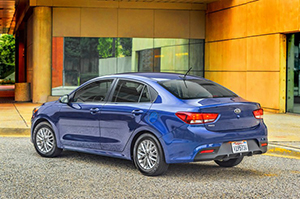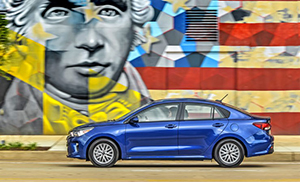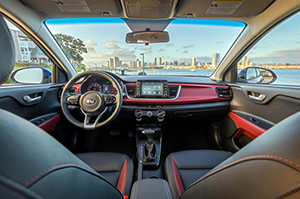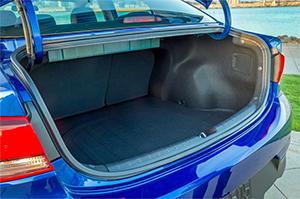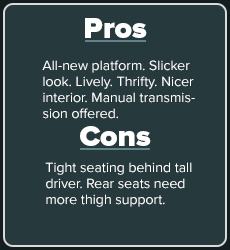2018 Kia Rio
The Kia Rio has significant
changes for 2018.
Prices: $13,900-$18,700
The redesigned 2018 fourth-generation Kia Rio sedan and hatchback
delivers more than you might expect from a subcompact economy car.
The fourth-generation 2018 Kia has an all-new platform and sharper
styling. It’s also longer, lower and wider. One wonders if
automakers will ever get away from the “longer, lower,
wider” theme, which was a big auto selling point starting in
the 1950s?
Not that Kia went overboard with that theme because the new
$13,900-$18,700 Rio’s wheelbase is just up to 101.6 inches
from 101.2 inches, and it’s 160 inches long, only up from
159.4 inches. Still, it’s a little lower and wider to give
it, as Kia puts it, “a more balanced and athletic
stance.” A well-creased shoulder line runs from front to
back, stretching the car’s appearance to give it a sleeker
and more substance look than, as Kia says, “what’s
currently found in the subcompact segment.”
The point is, you don’t look as if you’re pulling a
hair-shirt, poor-boy economy car up to a restaurant. You can even get
optional $195 Black Pearl paint.
The interior is more modern and upscale with an improved instrument
panel and upgraded materials. I found my test top-line Rio EX
hatchback’s 7-inch touch-screen infotainment system easy to
use, and there are handy large manual dashboard climate controls.
The redesigned front seats have more cushion and padding but should
provide more side support. And a passenger behind a tall driver will
want more knee room. Moreover the rear seat should provide more thigh
support. Cabin storage areas are average, but the console has a
bi-level tray to better accommodate portable devices such as
smartphones and small tablets.
My test EX’s interior looked especially good because it had
the $500 optional “Launch Edition” package that
contains red accent leather seat and interior trim.
Standard EX features include air conditioning, power window, door locks
and outside mirrors, telescopic steering column, multi-adjustable
driver’s seat, remote keyless entry, split/folding 60/40 rear
seats, AM/FM/MP3, Android Auto and Apple CarPlay.
Safety features include lots of air bags, a rear camera, autonomous
emergency braking and forward collision warning system.
The front-drive Kia Rio has the mechanical goods to back up its new
look. Powering the car is a 1.6-liter, 130-horsepower four-cylinder
with 119 pound/feet of torque. It’s advanced, featuring a
high-pressure fuel system with direct injection, variable intake
system, low-friction oil seals and even piston cooling-jets, which once
were found only in very high-performance cars. Moreover, it only emits
a mild drone under hard acceleration.
Estimated fuel economy is 29 in the city and 37 on highways with the
manual transmission and 28 and 37 with the efficient automatic, which
has a responsive manual-shift feature via the console-shift lever. Only
87-octane gasoline is needed. Fuel tank capacity is 11.9 gallons with
either transmission.
The new Rio comes as a four-door sedan and roomier four-door hatchback
and is lively, with good city and highway acceleration.
That’s partly because the base $13,900 Rio LX only weighs
2,648 pounds with a six-speed manual transmission, which gives it
sporty flair but is only offered for the LX. An LX with the six-speed
automatic is $14,990. Rio models with the automatic weigh 2,714 pounds.
There’s also a $16,100 mid-range S model and the $18,400 EX
model I drove.
The sedan has 13.7 cubic feet of cargo room, and the hatchback has 17.4
cubic feet feet of such space. With the 60/40 split-folding rear seats
down, the hatchback provides an impressive 32.8 cubic feet with a low,
flat cargo floor. The hatch has a deep indented area to help close it
without getting hands dirty on outside hatch.
My test car handled curves with good stability, thanks party to
traction and electronic stability controls and a vehicle stability
management system. The steering was quick but a little heavy. Tire
pressures on the low side may have partly accounted for that.
(Below-zero Chicago weather prevented me from getting pressures just
right.) The ride was supple, thanks partly to a revised spring and
damper setup for a more complaint and comfortable ride, although rough
pavement brought out slight body bounce
The brake pedal had a progressive feel, and the anti-lock brakes
stopped the car with no drama, even on icy pavement. Brakes are all
disc for the EX, but they are front disc/rear drum for the other Rio
versions.
The hatch swings open on struts, but the hood is held up with a prop
rod.
My test Kia Rio had solid construction and nice paint, although I
wished the car’s rather neutral “Urban
Gray” paint had been replaced by the more elegant
“Black Pearl.”

